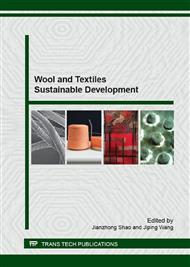p.71
p.78
p.88
p.95
p.103
p.109
p.115
p.121
p.133
A Study of the Ability of Modified Dyeing, and Post-Dyeing Processes to Increase the Crystallinity of Dyestuffs and the Lightfastness of Wool Textiles
Abstract:
We investigated whether the fastness properties of wool textiles could be enhanced by modifying the dyeing and post-dyeing procedures in ways designed to increase the crystallinity of dyes in the wool. In one approach, the dyebath was maintained at 98°C for three hours, in another, dyed fabric was rapidly cooled. In a third approach, dyed fabric was alternately held in solutions of 80°C and 40°C. Commercial acid levelling and acid milling dyes were used. Fastness to light and washing were assessed by standard methods, and samples were exposed to sunlight behind glass for 12 months. The crystallinity of the dyes in the wool was assessed by x-ray diffraction. Small increases in lightfastness and crystallinity occurred, with the two classes of dyes behaving differently. This preliminary study demonstrated that the concept of increasing the crystallinity of dyes in wool to improve lightfastness warrants further investigation.
Info:
Periodical:
Pages:
103-108
Citation:
Online since:
November 2015
Authors:
Price:
Сopyright:
© 2016 Trans Tech Publications Ltd. All Rights Reserved
Share:
Citation:


